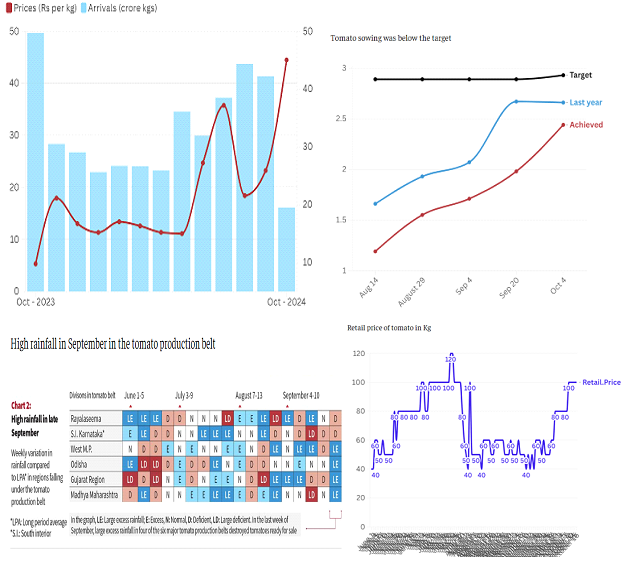THE CONTEXT: The recent surge in tomato prices across India has highlighted the vulnerabilities in agricultural supply chains, driven by adverse weather conditions and below-target sowing levels.

THE ISSUES:
- High Rainfall: Excessive rainfall in key tomato-producing regions, such as Rayalaseema and South Interior Karnataka, damaged crops and reduced the supply of tomatoes.
- Sowing Below Target: The tomato sowing was below the target levels. This shortfall in planting has contributed to reduced supply.
- Seasonal Fluctuations: The retail price fluctuates significantly, peaking at ₹120 per kg. Prices typically rise during monsoon due to disruptions in harvesting and transport.
- Mandi Arrivals: The mandi arrivals saw a sharp decline from August to September, more than halving, exacerbating price increases.
- Government Intervention: To stabilize prices, the government has intervened by selling tomatoes at subsidized rates (e.g., ₹65 per kg). Despite these efforts, prices remain high due to ongoing supply challenges.
- Market Dynamics: The role of market intermediaries during the high-demand festive season may have also contributed to price hikes. A significant portion of the consumer price is absorbed by intermediaries, reducing the share that reaches farmers. This inefficiency can lead to further market distortions.
THE WAY FORWARD:
- Strengthening Logistics: Enhance transportation and storage facilities to reduce spoilage and supply consistent fresh produce. For example, refrigerated trucks can help maintain the quality of perishable goods.
- Reducing Intermediaries: Minimize the role of intermediaries to decrease markups and lower consumer prices. Direct procurement initiatives like e-NAM can connect farmers directly with buyers, improving price transparency and reducing exploitation.
- Buffer Stock Management: Maintain buffer stocks of essential commodities to stabilize prices during periods of scarcity or price spikes. This approach can mitigate inflation volatility by strategically releasing stocks.
- Encouraging Private Markets: Develop private mandis through public-private partnerships to provide farmers with more selling options and competitive pricing.
- Trade Policy Alignment: Ensure that export restrictions and import duties are aligned with domestic procurement strategies to balance supply and demand effectively.
- Agricultural Productivity Enhancement: Encourage using modern farming techniques, such as precision agriculture and polyhouses, to increase crop yields and protect against pests. Invest in developing disease-resistant seed varieties and enhance intellectual property rights to incentivize private sector research.
THE CONCLUSION:
Addressing food inflation requires a multifaceted approach, including improved supply chain management, enhanced storage facilities, and policy reforms. By implementing these strategies, India can mitigate price volatility and ensure a stable supply of essential commodities.
UPSC PAST YEAR QUESTIONS:
Q.1 Assess the role of the National Horticulture Mission (NHM) in boosting horticulture farms’ production, productivity, and income. How far has it succeeded in increasing the income of farmers? 2018
Q.2 What are the causes of persistently high food inflation in India? Comment on the effectiveness of the RBI monetary policy in controlling this type of inflation. 2024
MAINS PRACTICE QUESTION:
Q.1 Examine the impact of climate variability on agricultural production and food inflation in India.
SOURCE:
Spread the Word
